Agentic AI vs. Generative AI: Differences
|
|
Artificial Intelligence (AI) is swiftly turning into an array of various branches, each one intended to fulfill specific tasks. Two of these are the Agentic AI and Generative AI; they are powerful, but fundamentally different approaches. Systems that make autonomous decisions are more oriented towards agentic AI, and allow the systems to work, act, and interact with their environment with minimal human assistance. These AI agents are goal-oriented and work based on designing, thinking, and implementing plans to attain particular results.
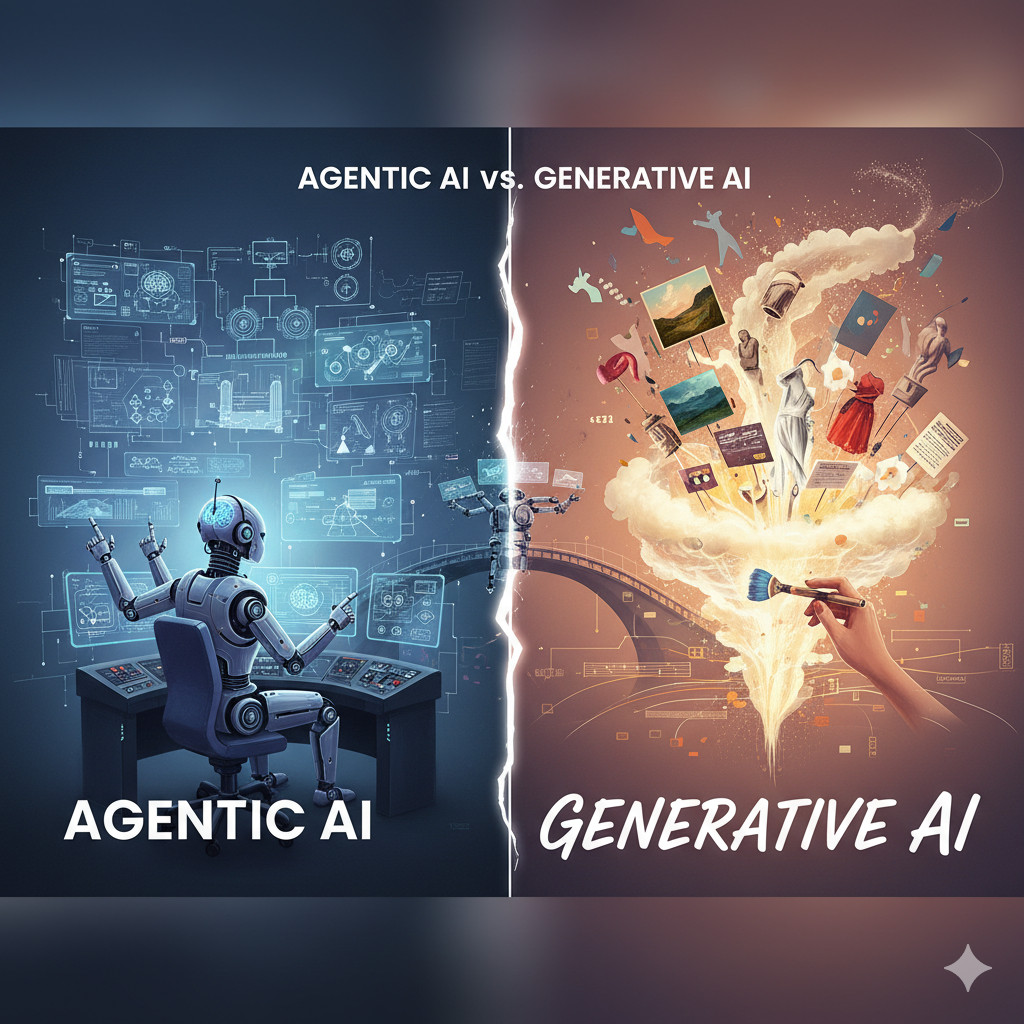
Generative AI, in contrast, focuses on creativity where it learns using the data to generate new information (text, images, music, or even code). Although both are based on the latest machine learning and deep neural networks, they have vastly different purposes and uses. One of them empowers machines to act, and the other empowers them to create. Collectively, they are opposing aspects of AI, bringing it to the convergence of autonomy and creativity.
| Key Takeaways: |
|---|
|
What is Generative AI: The Power of Creation
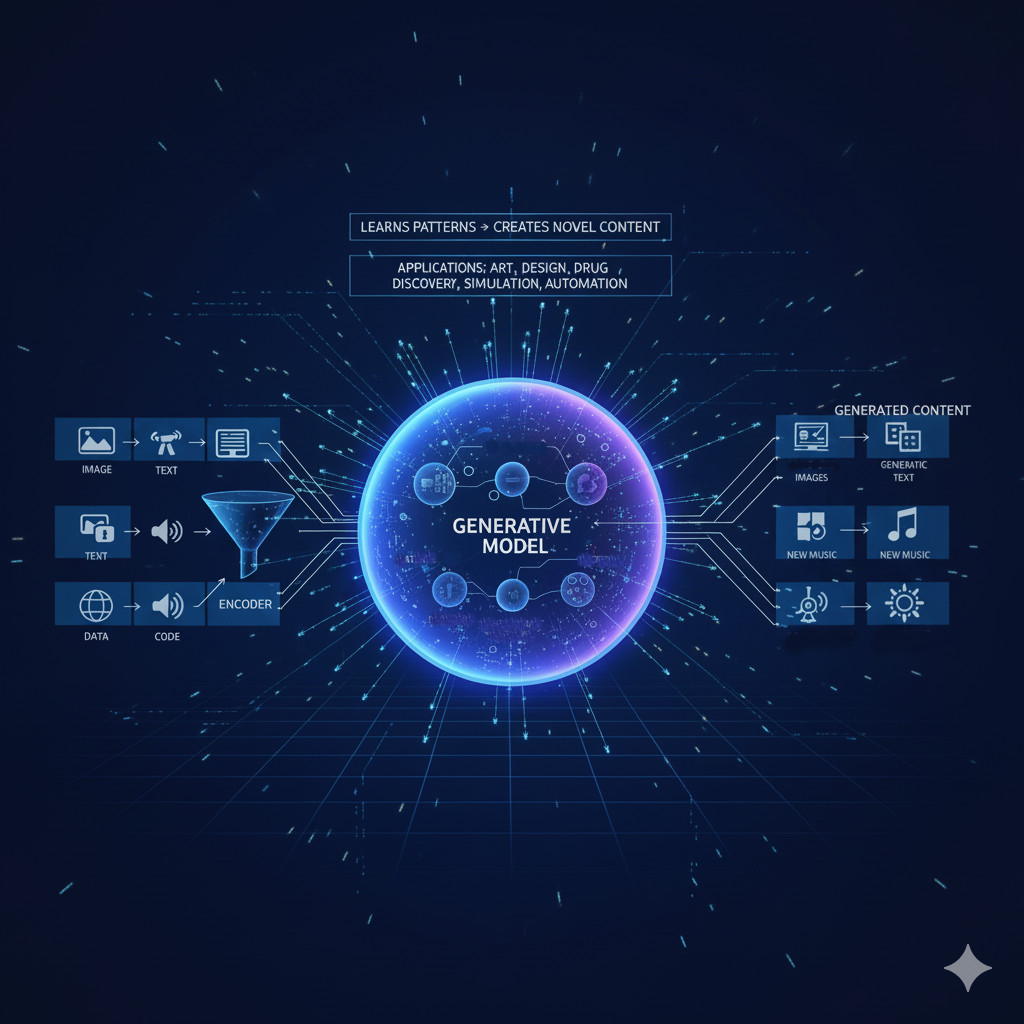
Generative models are a form of artificial intelligence that generates completely novel content. In contrast to traditional predictive models, which only predict or classify using the available data, generative models learn the overall trend and the distribution that exists in data and reproduce new text, images, audio or even code. The shift to production over prediction will underscore the way AI has ceased being a tool to aid analytics and has become a partner in the creative process and solving of problems.
The Foundations of Generative Models
Generative models are developed based on the concept of acquiring patterns of large data sets and generating new data similar to the previous one. In contrast with traditional predictive models, which are based on the prediction of outcomes, generative models are aimed at creating new text, image, audio or even structured data, and the simulation of reality. These models make use of deep learning methods, especially neural networks, to learn complex relationships in data.
- Get patterns and distributions of existing datasets.
- Produce new and original outputs, i.e., text, pictures, code.
From Prediction to Production
AI has gone past the prediction of numbers or label classification, and is now an all-around solution providing advantageous outputs. Generative AI fills this gap by going beyond information analysis and generating content. This shift has made AI more of a useful tool to support analytics, and also for an active cooperation in media, health, and education sectors.
- Prediction = the study of and the categorization of data.
- Production = a creation of something substantial new.
- Allows automation of knowledge-intensive and creative work.
Read more about Generative AI in Software Testing.
What is Agentic AI: The Power of Action
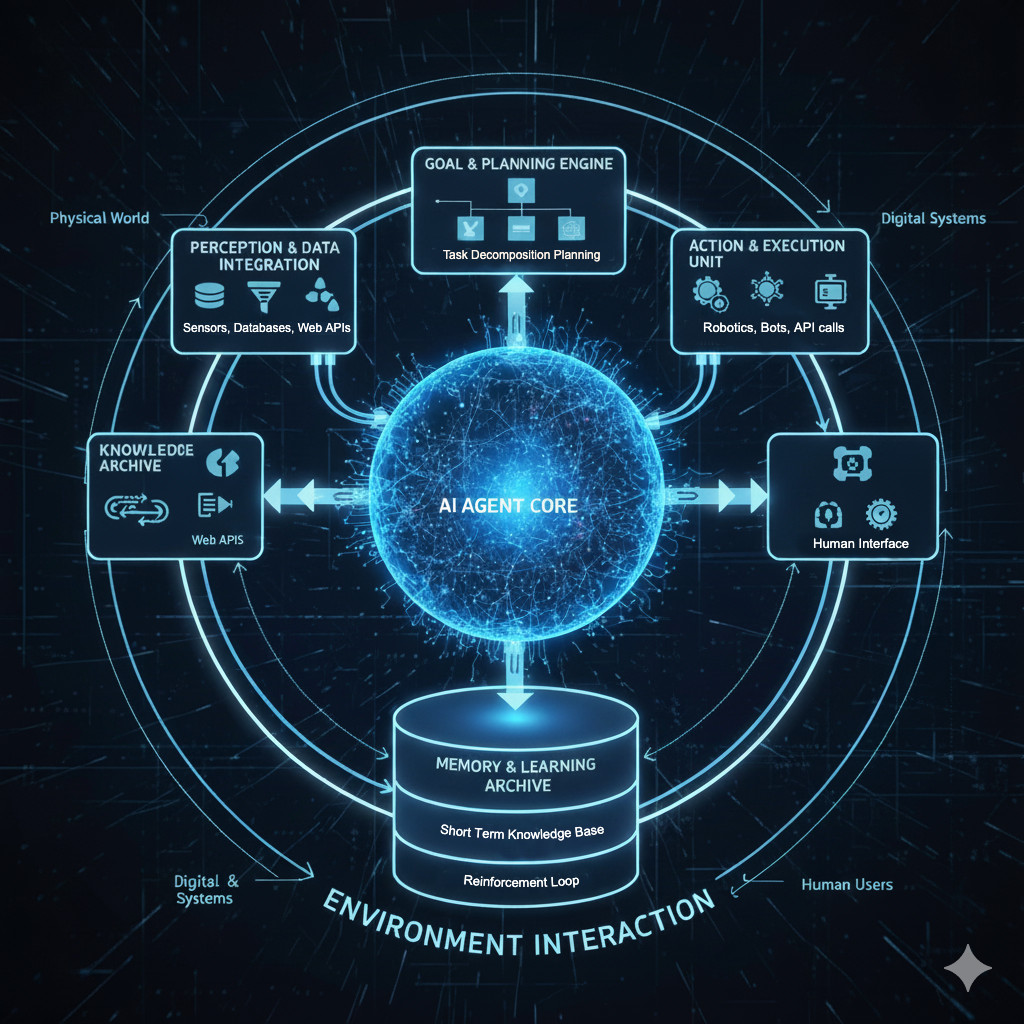
Agentic systems are a type of artificial intelligence commonly labeled as agentic, which is not merely some sort of robot following instructions but functions as a purposeful system instead. These systems are autonomous in that, unlike their traditional counterparts, they observe their surroundings, evaluate available options and act on them to achieve set objectives.
The real potential of agentic AI would be the transition of assistive technology to self-sufficiency. The first application of AI was primarily based on the support system, as humans are assisted with instructions or some small tasks. Agentic systems are able to take action by themselves, manage the working process, and solve issues with minimal supervision. This development brings about increased efficiency and simultaneously increases the importance of the system and the ethics of responsible use.
Defining AI Agency in Machines
Agency in machines is their capacity to take action intentionally instead of being governed by an organization of instructions in a program. The agentic AI system does not simply respond to incoming orders but is capable of breaking down scenarios, strategizing, and executing them with respect to certain objectives. This provides machines with a behavior, which allows them to respond and adapt to the changing times in a timely fashion, as it:
- Grows past the feature of reactive behavior and moves to proactive behavior.
- Oriented on goal achievement instead of doing predetermined tasks.
- Flexible in behavior depending on the circumstances and setting.
How Agentic Systems are Structured
The agentic systems are designed based on an overlay that offers a combination of perception, reason, and performing action. Perception enables them to receive input from either sensors or a stream of data. The information is processed by reasoning, there are possible courses of action, and the most effective course of action is chosen by reasoning. These decisions are then implemented by the action layer with feedback loops that guarantee improvement and betterment over time.
- Model: Gathers both physical and virtual information.
- Rationalizing: Data analytics and decision-making.
- Action: This performs tasks and varies according to feedback.
The Shift from Assistance to Autonomy
The AI systems have transformed from passive assistants into autonomous agents. Previously, they helped with suggestions, e.g., automation of repetitive tasks, which humans always controlled. However, currently, agentic AI has the ability to plan and act independently, meaning that one does not need to monitor it constantly. Such a change makes business more efficient, yet requires a high level of control in order to teach accountability and conformity to human values.
Read more about AI Agents in Software Testing.
Gen AI vs. Agentic AI: Creation vs. Action
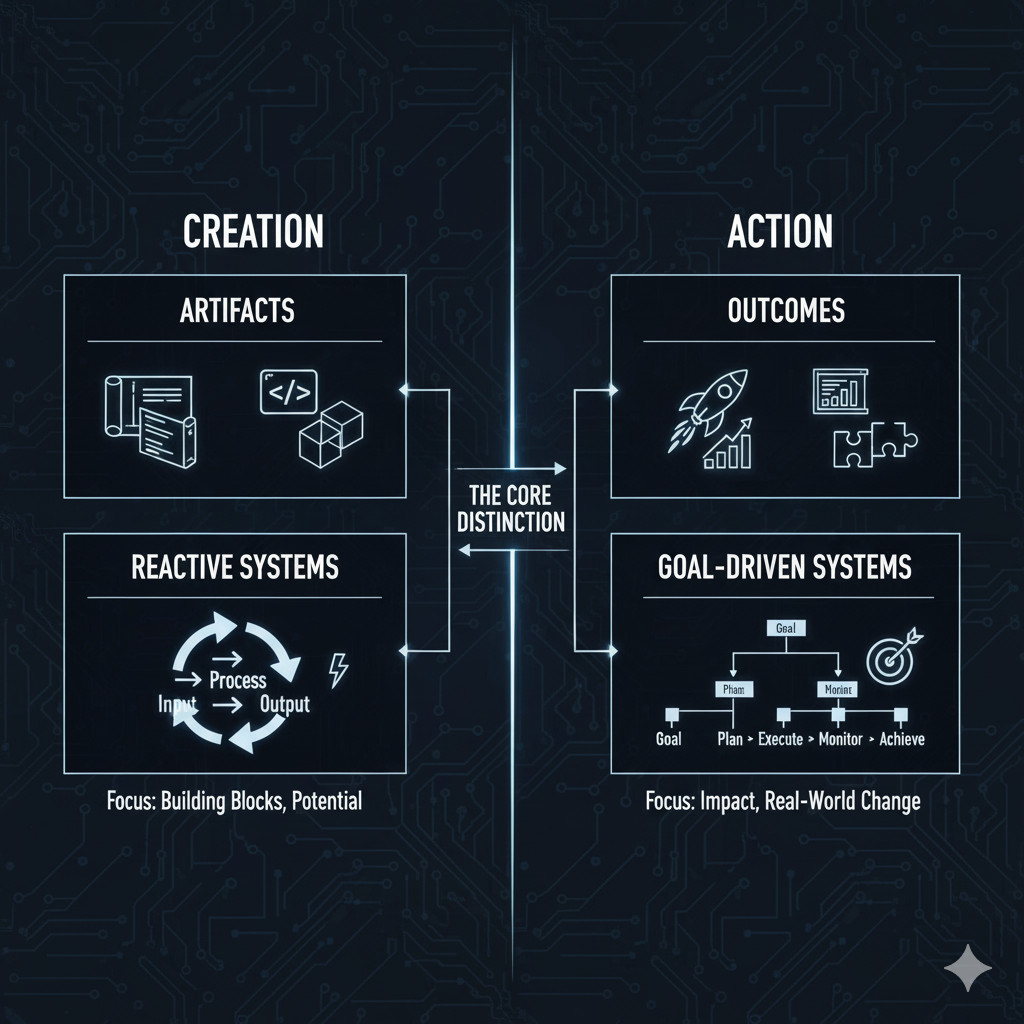
The main distinction between generative systems and agentic systems is that, at the core of emerging AI, one system is dedicated to creating something. In contrast, the other is devoted to doing it. Generative AI can create new texts, images, code, or music after modeling trends based on existing data. Its advantages are originality and the generation of content. In comparison, agentic AI emphasizes the intentional acts, in which the machine directly takes decisions, initiates operations, and attains objectives in dynamically changing situations. They collectively possess two complementary aspects of intelligence: the creative and the operative.
Artifacts vs. Outcomes
Generative AI is more about creating material products—creative outputs that reflect humans’ expression. It also adds value through improving creativity, supporting design, and providing new content. On the contrary, agentic AI is gauged by the consequences that it generates via choice and action, e.g., the resolution of a logistics problem or a robotic path.
- Generative AI: It is involved in the generation of artifacts such as text, art or some form of simulation.
- Agentic AI: It aims to attain real-life results through purposeful action.
- Niche Distinction: One used measurement of success based on the quality of creation, the other based on the efficiency of outcomes.
Reactive Systems vs. Goal-Driven Systems
Many early AI systems are reactive systems that simply react to input without any planning or foresight. In this reactive mode, generative AI is commonly formed to produce outputs or something in response to prompts or datasets. To the contrary, agentic AI is purposeful: it does not just respond but plans, reasons, and amends as a means to attain goals. This contributes to the improved application of agentic systems to autonomous work related to robotics, decision-making, and digital activities.
- Take Action: Goal-oriented, acting rationally to achieve set goals and objectives.
- Outcome: Generative AI tends to respond, and agentic AI tends to achieve a goal.
Technical Foundations of the Two Paradigms
Technological origins of the generative and agentic AI refer to the opposing yet collaborative purposes of these technologies within the wider context of AI. Its power lies in the distribution, understanding, and creation of new products that reflect human ingenuity. By contrast, agentic AI takes the form of an orchestration, which combines perception, reasoning, and action in a goal-oriented process. It is based on planning algorithms, reinforcement learning, and adaptive feedback loops, which enable systems to be operated independently in dynamic environments.
Generative AI as a Representational Engine
Generative AI can be viewed as a representational engine, which is conditioned to obtain the underlying patterns, structures, and distributions of data. Its main aim is to acquire the information in the way the information is displayed and, thereafter, create new innovative ways of expression. It is able to produce text, images, or any other outputs that will look similar to human-created content with the help of deep learning structures, including transformers, variational autoencoders, and diffusion models.
- Tries to identify latent patterns of large data sets.
- Develops realistic and contextually sensible products.
- It is mostly a mechanism of content creation.
Agentic AI as an Orchestration Framework
The agentic AI is used as an organizing system, which is aimed at coordinating perception, reasoning, and action in order to achieve specific goals. In contrast to the generative models, content creation is not its primary purpose but an act of decision-making and realization. The agentic systems combine planning algorithms, reinforcement learning, and feedback loops that enable the implementation of machines in response to changing environments, technically.
- Applies feedback loops as a way of constant adjustment.
- Plays the role of a perception, reasoning, and acting coordinator.
Integration and Interdependence
In spite of their different designs, generative and agentic AI are becoming increasingly dependent on each other. Generative AI develops the functionality of agentic systems, offering context-rich artifacts, such as natural language generation or a simulated world, that agents may reason about. In contrast, agentic AI enables generative systems to be empowered by being integrated into bigger systems, allowing them to be used as goals. Collectively, they constitute a synergy; one gives the creativity, and the other gives the action.
Tools like testRigor illustrate how these paradigms converge in practice: Generative AI enables effortless test creation in plain English, while agentic capabilities allow tests to adapt, self-heal, and act autonomously when applications evolve.
Autonomous AI and Human Oversight
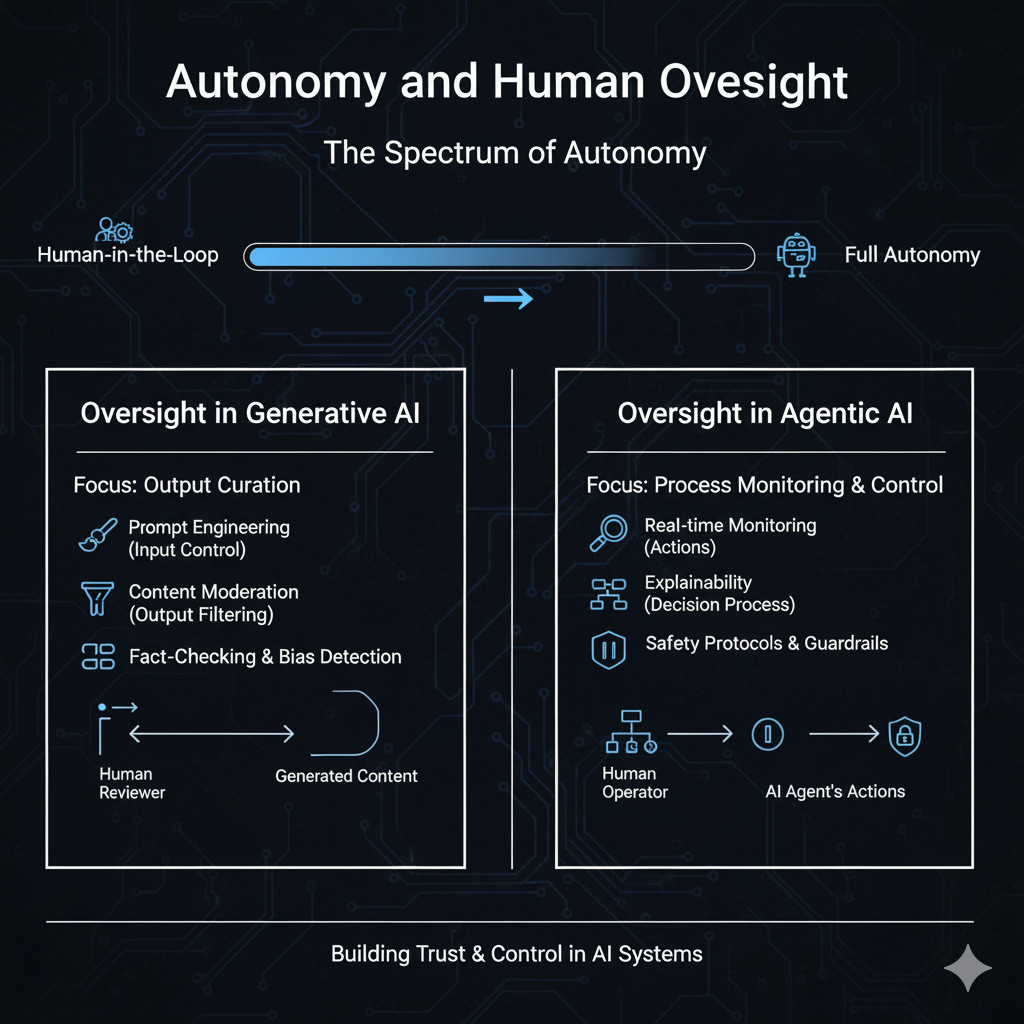
Autonomy in AI describes the level at which systems can act without human intervention, whereas human supervision can be used to guarantee that autonomy does not harm the safety, morality, and responsibility. A strike between the two is the key to the creation of trust in AI, with excessive autonomy odds and too much regulation reducing the scope of innovation.
The Spectrum of Autonomy
The use of AI systems is on a continuum where the simplest are rule-based assistants that require constant input before making a decision, and highly autonomous entities that are able to make complex decisions. The knowledge of this spectrum aids organizations in determining the degree of freedom to put under the machine.
- Low autonomy: System vulnerable to human commands.
- Medium autonomy: Systems are semi-autonomous but must be validated.
- High autonomy: Systems create and make decisions without human involvement.
Oversight in Generative AI
Generative AI needs close monitoring since it generates content that is creative and does not necessarily correspond to truth, morals, and situational appropriateness. Outputs should be reliable and should be appropriate, which requires human scrutiny.
Oversight in Agentic AI
The agentic AI is more independent and may often make real-time decisions. Monitoring performance and setting limits are some of the elements of oversight with respect to making sure that systems are responsible in their actions.
- Provide specific objectives and requirements of the agent.
- Follow up on what is going on by using feedback loops.
Value for Organizations: Agentic AI vs. Generative AI
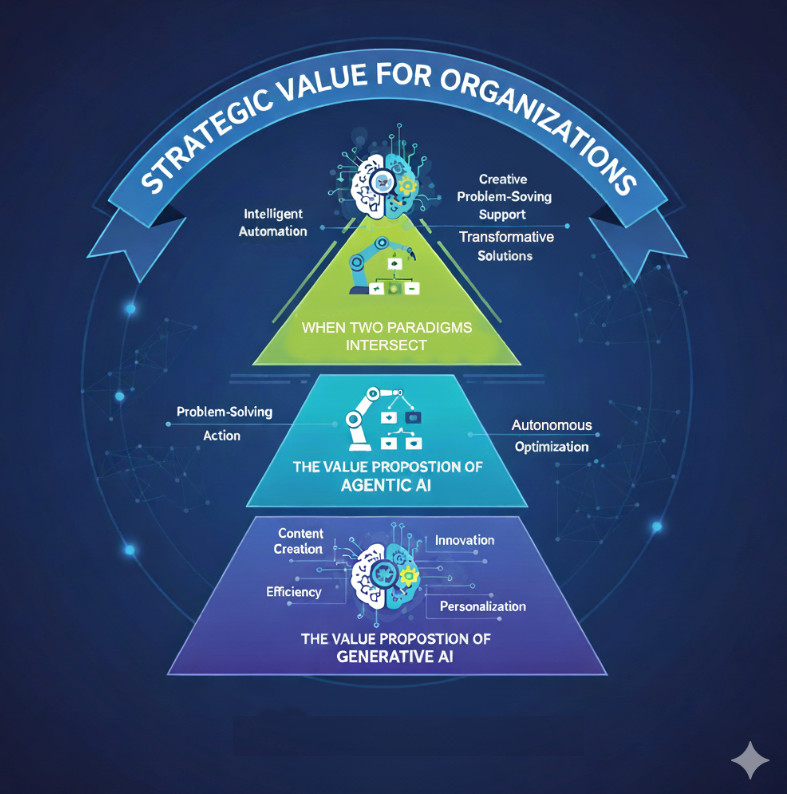
The strategic importance of AI to organizations is that it helps increase creativity and efficiency. Generative AI enhances innovation in creating content, designs, and ideas that accelerate workflow and minimize cost. Moreover, agentic AI provides operational autonomy, providing systems with the possibility to perform autonomously and make processes scalable.
As two paradigms combined, there is a synergy and generation of ideas and their implementation. In quality assurance, testRigor combines these strengths by reducing the creative overhead of writing tests while also providing agentic adaptability that ensures automation doesn’t break when the application changes.
The Value Proposition of Generative AI
Generative AI can give organizations creative strength and efficiency. It saves both time and cost of the content production process and creates new possibilities for innovation and design. It has the ability to empower employees in various departments with their ideas. It is also particularly helpful in industries that create their value through creativity, like media, design, and education.
The Value Proposition of Agentic AI
The value that agentic AI creates is that of independence and scalability in an organization. It is able to continuously observe any environment and make decisions on its own so as to reach goals.
- Operational Autonomy: Controls working processes without necessarily seeking human oversight.
- Adaptive Learning: Adapts to the real-time conditions, which enhances accuracy and speed.
When the Two Paradigms Intersect
Generative and agentic AI work together in a synergy that is very powerful. Generative AI can be used to provide ideas, whereas agentic AI makes things happen so that it forms an end-to-end intelligent system.
- Strengths Collaboration: The combination of the two connects an innovation to a meaningful action in order to make solutions creative and effective.
- Future Advantage: The integration will develop intelligent ecosystems that are competitive and sustainable for organizations.
Risks and Limitations
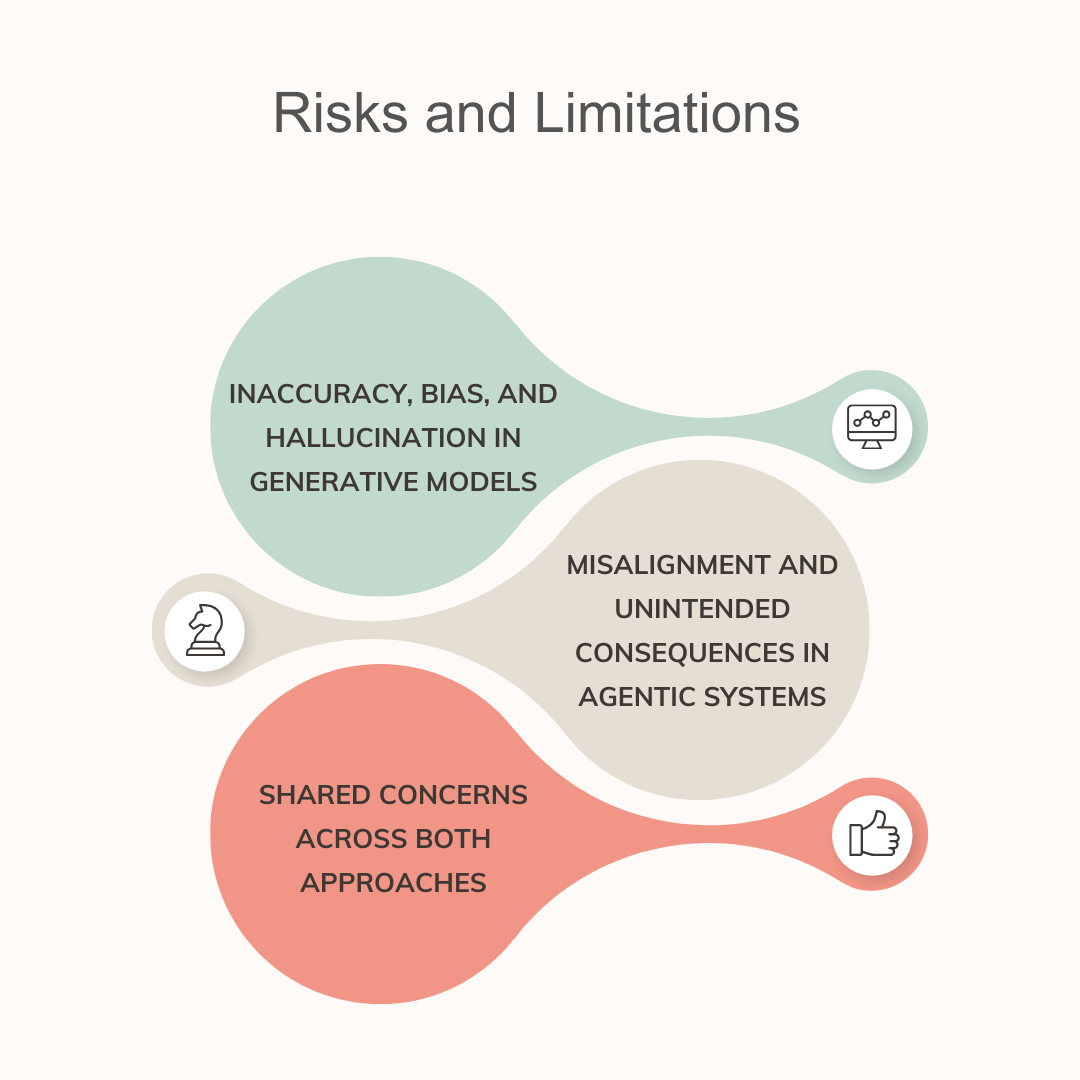
There are potentially transformative opportunities that AI technologies offer, but risks also exist, which should be handled in a responsible manner. There are a variety of limitations to which both generative and agentic systems are limited.
Inaccuracy, Bias, and Hallucination in Generative Models
Outputs generated by generative AI can look real, but may be misleading or biased, leading to concerns about trustworthiness and responsible use. Such systems generate occasionally true but falsely believable information, known as hallucinations, and could mislead the users. Moreover, models generally learn social, cultural, or historical biases in the training data, which yield unbalanced results. Such problems raise ethical considerations when fairness, decision-making, or representation come into play in potentially sensitive applications. Read: What are AI Hallucinations? How to Test?
Misalignment and Unintended Consequences in Agentic Systems
The problem of agentic AI is that the alignment will always be problematic since system goals cannot match human intentions. If an autonomous system is biased and runs to the ‘wrong‘ target, it may result in adverse or unintended effects. Such a system could be agentic in nature, with the primary goal being to maximize efficiency in the logistics sector, with no concern for things like worker safety or environmental impact. To specify a correct alignment over the system, intensive designing and continuous monitoring are needed, as well as explicit human value to be given to the system goal.
Shared Concerns Across Both Approaches
There are some risk factors that are shared between generative and agentic AI and have different characters. One of the significant challenges is accountability, it’s hard to hold these systems accountable when they get things wrong or cause harm, especially if they’re self-operating. Both also come with risks of misuse, through which people can use them to spread misinformation, orchestrate cyberattacks or perpetuate dangerous automation. Read: Top 10 OWASP for LLMs: How to Test?
Future Directions and Convergence
The future of AI lies in merging generative and agentic paradigms, combining creativity with autonomy to both design and implement solutions. This integration will accelerate innovation, enhance human-AI collaboration, and expand problem-solving potential. However, its promise must be balanced with ethical safeguards, regulatory oversight, and responsible design.
Platforms like testRigor represent this convergence where AI not only helps create test cases but also ensures their ongoing reliability through autonomous execution and intelligent adaptation.
The Likely Integration of the Two Paradigms
Generative and agentic AI continue to converge, combining creativity with expression and action into unified mechanisms. Generative AI will generate new ideas, and agentic AI will implement them into the physical world, forming fluid systems that span from ideation to production. These systems can provide meaningful, context-sensitive responses with contextual intelligence and orchestration. This integration has industry cross-cutting implications; it could empower sectors, including health and design, with imaginative, autonomous, and result-based answers.
Toward Creative Autonomy
When generative and agentic AI finally converge, it will be the dawn of creative autonomy, where machines can generate and apply solutions. Robotic systems will not replace humans; rather, they will be our partners to enrich creativity and jointly design. Thanks to their ability to scale workloads, they can more effectively solve complex problems, like climate modeling or global logistics.
Balancing Innovation With Responsibility
Although combining generative and agentic AI holds great potential, it also introduces control, safety, and ethical concerns. But to make sure that these systems are helpful, we need strong frameworks to guard against misuse, bias and harm. To ensure accountability, governments and industry should institute transparency requirements, while future AI systems must be designed to allow for explanation around how a decision was reached in a way that people can understand.
Wrapping Up
Generative AI and agentic AI represent two complementary but distinct paradigms: one fuels creativity by generating novel content, while the other drives purposeful action through autonomous decision-making. Together, they embody the convergence of creation and execution, offering organizations both innovation and operational efficiency. The future lies in their integration, where creativity meets autonomy to unlock transformative possibilities, balanced always with ethical responsibility and oversight.
| Achieve More Than 90% Test Automation | |
| Step by Step Walkthroughs and Help | |
| 14 Day Free Trial, Cancel Anytime |












